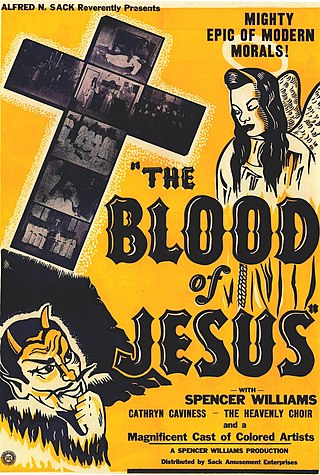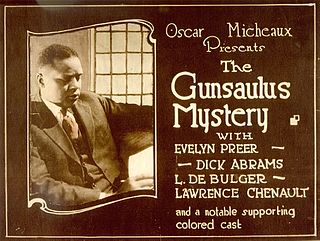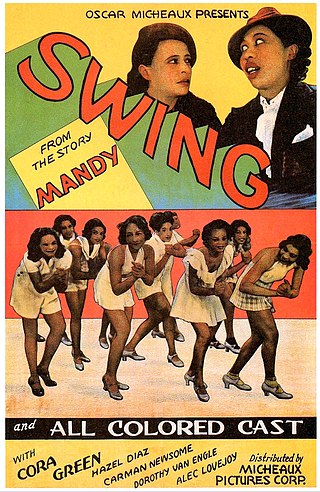
The Blood of Jesus is a 1941 American independent fantasy drama race film written, directed by and starring Spencer Williams. The plot concerns a Baptist woman who, after being accidentally shot by her atheist husband, is sent to a crossroads, where Satan tries to lead her astray.

Within Our Gates is a 1920 American silent film by the director Oscar Micheaux that portrays the contemporary racial situation in the United States during the early twentieth century, the years of Jim Crow, the revival of the Ku Klux Klan, the Great Migration of blacks to cities of the North and Midwest, and the emergence of the "New Negro". It was part of a genre called race films.

Oscar Devereaux Micheaux (; was an American author, film director and independent producer of more than 44 films. Although the short-lived Lincoln Motion Picture Company was the first movie company owned and controlled by black filmmakers, Micheaux is regarded as the first major African-American feature filmmaker, a prominent producer of race films, and has been described as "the most successful African-American filmmaker of the first half of the 20th century". He produced both silent films and sound films.

Evelyn Preer, was an African American pioneering screen and stage actress, and jazz and blues singer in Hollywood during the late-1910s through the early 1930s. Preer was known within the Black community as "The First Lady of the Screen."

The race film or race movie was a genre of film produced in the United States between about 1915 and the early 1950s, consisting of films produced for black audiences, and featuring black casts. Approximately five hundred race films were produced. Of these, fewer than one hundred remain. Because race films were produced outside the Hollywood studio system, they were largely forgotten by mainstream film historians until they resurfaced in the 1980s on the BET cable network. In their day, race films were very popular among African-American theatergoers. Their influence continues to be felt in cinema and television marketed to African-Americans.
Gertrude Sanborn was an American journalist, short story writer, and novelist.

Lawrence Chenault was an American vaudeville performer and silent film actor. He appeared in approximately 24 films between years 1920 and 1934; most of his performances were in films directed by pioneering African-American filmmaker Oscar Micheaux. His brother, Jack Chenault, was also a film actor.

The Gunsaulus Mystery is a 1921 American silent race film directed, produced, and written by Oscar Micheaux. The film was inspired by events and figures in the 1913-1915 trial of Leo Frank for the murder of Mary Phagan. The film is now believed to be lost. Micheaux remade the film 1935 as Murder in Harlem.

Swing! is a 1938 American race film directed, produced and written by Oscar Micheaux.

A Daughter of the Congo is a 1930 race film directed, written and produced by Oscar Micheaux. The film is loosely based on the novel The American Cavalryman (1917), by African-American novelist and playwright Henry Francis Downing. It is considered a lost film.

Veiled Aristocrats is a 1932 American Pre-Code race film written, directed, produced and distributed by Oscar Micheaux. The film deals with the theme of "passing" by mixed-race African Americans to avoid racial discrimination. It is a remake of The House Behind the Cedars (1927), based on a novel by the same name published in 1900 by Charles W. Chesnutt. Micheaux may have borrowed the new title from a 1923 novel by Gertrude Sanborn.

The Dungeon is a 1922 race film directed, written, produced and distributed by Oscar Micheaux, considered the African-American Cecil B. DeMille due to his prolific output of films during the silent era, one of his greatest works being Body and Soul (1924). The Dungeon was his first horror effort, an early blaxploitation take on the Bluebeard legend.
The Symbol of the Unconquered is a 1920 silent "race film" drama produced, written and directed by Oscar Micheaux. It is Micheaux's fourth feature-length film and along with Within Our Gates is among his early surviving works. The Symbol of the Unconquered was made at Fort Lee, New Jersey, and released by Micheaux on November 29, 1920. A print of the film is extant at the Museum of Modern Art in New York. The film is based on the way perceptions of race shape human relationships.
Pearl Bowser was an American author, collector, television director, film scholar, film director, producer, filmmaker, independent distributor and film archivist. Along with her peers Mel Roman and Charles Hobson, Bowser researched and curated "The Black Film" retrospective at the Jewish Museum in 1970. This prompted a new wave of public interest into "exhibiting, producing, and engaging with African American cinema beyond borders". Most of her exalted career was spent traveling the globe in order to cultivate audiences for marginalized filmmakers. An example of her efforts, and also her most groundbreaking work, manifested in her research on "early-1900s Black film pioneer Oscar Micheaux". This research can be seen in her book on the first ten years of the career of Oscar Micheaux, an African-American who directed 40 "race pictures" between 1918 and 1940. She is thus credited for having helped rediscover some of Oscar Micheaux's rare surviving films. She is the founder of African Diaspora Images, a collection of visual and oral histories that documents the history of African-American filmmaking. Part of her journey included teaching young people film in the 1960s and 1970s.

The film By Right of Birth premiered on June 22, 1921, in Los Angeles, California. This film was one of the few surviving films of the Lincoln Motion Picture Company, which is known as the first producer of race films and of such silent films as By Right of Birth. The company was founded in 1916 and in 1923 produced its last movie, The Heart of a Negro.
The Spider's Web is a 1926 American film directed by Oscar Micheaux which stars Evelyn Preer. It was remade in 1932 as The Girl from Chicago.
The Broken Violin is an American silent film directed by Oscar Micheaux, released in 1928.

African American cinema is loosely classified as films made by, for, or about Black Americans. Historically, African American films have been made with African-American casts and marketed to African-American audiences. The production team and director were sometimes also African American. More recently, Black films featuring multicultural casts aimed at multicultural audiences have also included American Blackness as an essential aspect of the storyline.
The Midnight Ace is a 1928 American crime film. Abe DeComathiere, Mabel Kelly and Oscar Roy Dugas starred. The film was directed by John H. Wade for Swan Micheaux's Dunbar Film Company. Swan Micheaux was Oscar Micheaux's brother. Swan had worked for Oscar before a failling out over his management of finances. Swan left and formed the Dunbar film company but it only made this film.
Pioneers of African-American Cinema (2015) is a digitally restored anthology collection of independent Black cinema from the first half of the 20th century.












